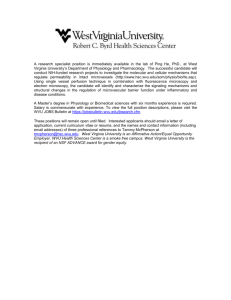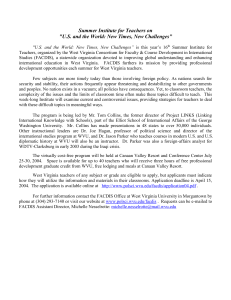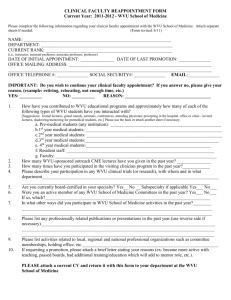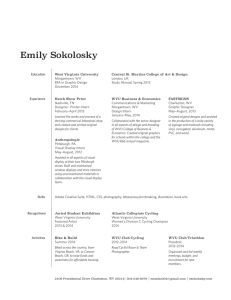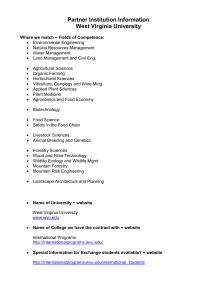Workshop Guide for in session activity
advertisement
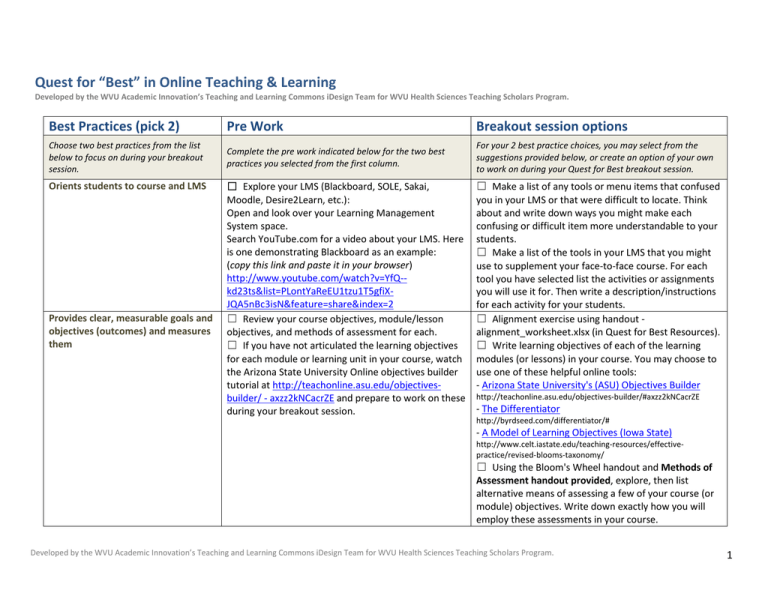
Quest for “Best” in Online Teaching & Learning Developed by the WVU Academic Innovation’s Teaching and Learning Commons iDesign Team for WVU Health Sciences Teaching Scholars Program. Best Practices (pick 2) Pre Work Breakout session options Choose two best practices from the list below to focus on during your breakout session. Complete the pre work indicated below for the two best practices you selected from the first column. For your 2 best practice choices, you may select from the suggestions provided below, or create an option of your own to work on during your Quest for Best breakout session. Orients students to course and LMS Provides clear, measurable goals and objectives (outcomes) and measures them ☐ Explore your LMS (Blackboard, SOLE, Sakai, Moodle, Desire2Learn, etc.): Open and look over your Learning Management System space. Search YouTube.com for a video about your LMS. Here is one demonstrating Blackboard as an example: (copy this link and paste it in your browser) http://www.youtube.com/watch?v=YfQ-kd23ts&list=PLontYaReEU1tzu1T5gfiXJQA5nBc3isN&feature=share&index=2 ☐ Review your course objectives, module/lesson objectives, and methods of assessment for each. ☐ If you have not articulated the learning objectives for each module or learning unit in your course, watch the Arizona State University Online objectives builder tutorial at http://teachonline.asu.edu/objectivesbuilder/ - axzz2kNCacrZE and prepare to work on these during your breakout session. ☐ Make a list of any tools or menu items that confused you in your LMS or that were difficult to locate. Think about and write down ways you might make each confusing or difficult item more understandable to your students. ☐ Make a list of the tools in your LMS that you might use to supplement your face-to-face course. For each tool you have selected list the activities or assignments you will use it for. Then write a description/instructions for each activity for your students. ☐ Alignment exercise using handout alignment_worksheet.xlsx (in Quest for Best Resources). ☐ Write learning objectives of each of the learning modules (or lessons) in your course. You may choose to use one of these helpful online tools: - Arizona State University's (ASU) Objectives Builder http://teachonline.asu.edu/objectives-builder/#axzz2kNCacrZE - The Differentiator http://byrdseed.com/differentiator/# - A Model of Learning Objectives (Iowa State) http://www.celt.iastate.edu/teaching-resources/effectivepractice/revised-blooms-taxonomy/ ☐ Using the Bloom's Wheel handout and Methods of Assessment handout provided, explore, then list alternative means of assessing a few of your course (or module) objectives. Write down exactly how you will employ these assessments in your course. Developed by the WVU Academic Innovation’s Teaching and Learning Commons iDesign Team for WVU Health Sciences Teaching Scholars Program. 1 Actively engages learners ☐ Go to https://coi.athabascau.ca/ and read about the Community of Inquiry (CoI) model. Be sure to explore the links to Cognitive Presence, Social Presence, and Teaching Presence. ☐ Using the CoI model, identify elements of your course that could be reworked to fit into Social Presence. List 2 or 3 ways that you might approach this. (e.g., discussion, Collaborate session, etc. ) ☐ Select an element of your course that could be presented as an interactive branching scenario. Start by writing out the initial problem and possible choices one might make to move toward a solution. You may not be able to finish the entire scenario, but create as many branches as you can during our breakout session, complete with constructive (or encouraging) feedback. Explore the example at http://community.wvu.edu/~lsm018/ABA Adventure/media/story.html Encourages student collaboration and dialogue ☐ Read http://chronicle.com/article/Watering-theRoots-of/140135/. ☐ Read http://www.cte.cornell.edu/teachingideas/engaging-students/collaborative-learning.html ☐ Add an online discussion to your course activities. Write a description explaining to students how this will be done in your course. Begin constructing a rubric you can use to grade the discourse. ☐ Identify an aspect of your course that students can work on in groups. Possibilities include: preparing a course glossary for new terminology; research a topic that the group can deliver or present to whole class; develop a scenario; etc. Developed by the WVU Academic Innovation’s Teaching and Learning Commons iDesign Team for WVU Health Sciences Teaching Scholars Program. 2 Provides timely and meaningful feedback ☐ Read http://www.facultyfocus.com/articles/online- ☐ A rubric can provide "up front" feedback. Select an education/effective-feedback-strategies-onlineassignment you currently have in your course that needs classroom/ a rubric and create it. ☐ Look at the deliverables for each of your assessment activities and determine what amount of time is both "timely" and realistic for providing feedback for each. (e.g., homework - 3 days; essay quizzes; 4 days; papers one week, etc.) Compose a paragraph that you will add to your syllabus to inform students. ☐ Along the same lines as above, identify what assessment activities will accommodate feedback to everyone in your class at once via the Announcements Tool in Blackboard. Models Universal Design for Learning ☐ Read opening page and peruse the Quick Links at http://online.wvu.edu/Faculty/Resources/UDL/. ☐ List the items in your course that are presented in only one way. Write down some alternative ways you might present that material. (e.g., text to visual, visual to audio, visual to text transcript, etc.) Models legal copyright use and appropriate citations ☐ Read http://www.knowyourcopyrights.org/resources-forteaching-faculty/frequently-asked-questions ☐ Using the sample letter provided in Quest for Best Resources, write a letter requesting permission to use a copyrighted work. At the end of the breakout session, participants will be asked to identify what they did during the session, what obstacles they encountered, and what action steps they will commit to completing after the session is over. Developed by the WVU Academic Innovation’s Teaching and Learning Commons iDesign Team for WVU Health Sciences Teaching Scholars Program. 3
